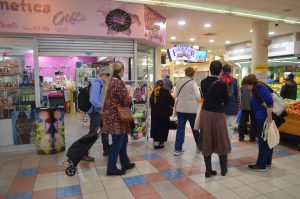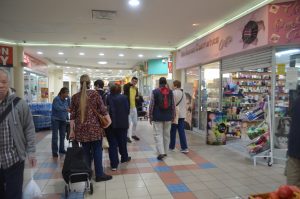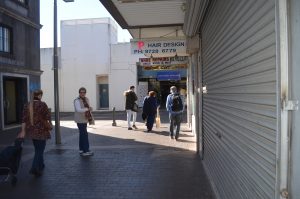In the first two posts, I sauntered through gendered and racialised aspects of walking as work through discussions of waitressing and ethnic tour guides. My first post was inspired by writing on the skilled bodily labour of waitressing. The second post meandered on ‘shepherding’ – how ethnic food tour guides in Western Sydney help tourists walk through racialised spaces. In this third post, I want to mosey around ethnomethodological studies of walking to rethink the skill and labour of the ethnic tour guides. Ethnomethodologists study the social organisation of mundane practices and how these are accomplished by local members in micro social interactions. Although I am not an ethnomethodologist, I enjoy reading the verbally poetic descriptions which make the pedestrian full of life. For instance, in a paper on walking and mobile apps, Eric Laurier and colleagues write:
Pedestrians do not just walk. They rush, they dawdle, they stroll, they amble, they circle, they pause, they stop, they edge past, they saunter, they plod, they advance, they retreat, they backtrack, they lead, they follow. Walking happens as a host of more prepositional, intentional and consequential actions: they walk towards, they walk away, they walk off, they walk into (Laurier et al., 2016: 117).
Early classic Lincoln Ryave and James Scheinken’s (1974) study examines how pedestrians show whether they are ‘walking together’ or ‘walking alone’. ‘Doing walking together’ entails being seen performing ‘togethering activities’ such as social proximity, uniformity of direction and pace, body contact and conversing (Ryave & Schenkein, 1975: 271; Collinson, 2006).
Guides and tourists have to work to enable the group to be ‘identifiable as a proper togethering’ on the streets and in the shops (Ryave & Scheinken, 1974) . The guides themselves walk with the tourists and sometimes walk alone but have to be intelligible as both walking together with the group but apart from them. One way they do this is to talk to the group walking backwards. The guides help the tourists repair themselves when they as a ‘mobile unit’ walking side by side are ‘broken up’ by other pedestrians, shopping aisles, food stalls, cars etc (Laurier et al, 2016; Weilenmann, Normark, & Laurier, 2014).
To re-assemble, tourists hurry themselves up, move out of being in a file to walking side by side, sharing pace. Guides do repair work too, setting the pace, creating the trajectory for the tourists to follow. Bodies, posture, gait, glances, aural cues, proximity, talking all enable guides and tourists work to produce the group togetherness and maintain walking together as a ‘mobile unit’ when they perform ‘moving off’ or ‘moving on’ (Laurier et al., 2016; Weilenmann, Normark, & Laurier, 2014).
Laurier at al stress that walking is not just about movement but the ‘intentional actions’ that make up pedestrian practices and how these shift the categories walkers inhabit. For example, tourists may shift from browsing shops to standing together as the guides speaks to them to being diners. As they shift, they will be treated differently as shoppers or diners (2016: 212). Finally, studies show that walking involves actions such as stop and go, which all render being a tourist as intelligible to the locals.
Ethnomethodology studies make me think about how to see walking on food tours in close up and slow motion. At the same time, I wonder about how race and gender affect moving on, moving off, proximity, glances, togethering and pace, talking and repairs. My second post drew on Ahmed’s notion of ‘impressions’ and how race and space are produced through bodies, movement and emotions. In my final post, I will try to shepherd all of my thoughts into ideas which can walk together. Or maybe they will have to walk apart.
Collinson, J. A. (2006). Running-together: Some ethnomethodological considerations. Ethnographic Studies, 8, 17-29.
Laurier, E., Brown, B. & McGregor, M. (2016) Mediated Pedestrian Mobility: Walking and the Map App, Mobilities, 11:1, 117-134,
Ryave, A. L., & Schenkein, J. N. (1974). Notes on the art of walking in Roy Turner, (ed.),Ethnomethodology, Harmondsworth: Penguin.
Weilenmann, A., Normark, D., & Laurier, E. (2014). Managing walking together: The challenge of revolving doors. Space and Culture, 17(2), 122-136.


